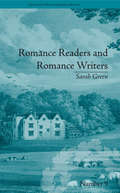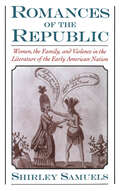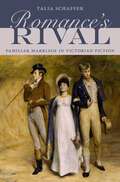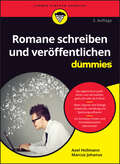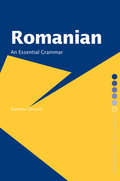- Table View
- List View
Romance Readers and Romance Writers: by Sarah Green (Chawton House Library: Women's Novels)
by Christopher GouldingThis edition of Romance Readers and Romance Writers (1810) is the first modern scholarly publication of what is arguably Green's most famous novel. As with many of her other works, Green adopts numerous sophisticated methods to parody her contemporaries.
Romance Readers and Romance Writers: by Sarah Green (Chawton House Library: Women's Novels #9)
by Christopher GouldingThis edition of Romance Readers and Romance Writers (1810) is the first modern scholarly publication of what is arguably Green's most famous novel. As with many of her other works, Green adopts numerous sophisticated methods to parody her contemporaries.
The Romance Verb: Morphomic Structure and Diachrony
by Martin MaidenThis book is the first comprehensive comparative-historical survey of patterns of alternation in the Romance verb which appear to be 'autonomously morphological': although they can be shown to be persistent through time, they have long ceased to be conditioned by any phonological or functional determinant. Some of these patterns are well known in Romance linguistics, while others have scarcely been noticed. The sheer range of phenomena which participate in these patterns in any case far surpasses what Romance linguists had previously realized. The patterns constitute a kind of abstract 'leitmotiv', running through the history of the Romance languages and conferring on them a distinctive morphological physiognomy. Although intended primarily as a novel contribution to comparative-historical Romance linguistics, the book considers in detail the status of these patterns which appear to be a matter of 'morphology by itself', unsupported by determining factors external to the morphological system. Particular attention is paid to the problem of their persistence, self-replication, and reinforcement over time. Why do abstract morphological patterns that quite literally 'do not make sense' display such diachronic robustness? The evidence suggests that speakers, faced with different ways of expressing semantically identical material, seek out distributional templates into which those differences can be deployed. In Romance the only available templates happen to be 'morphomic', morphologically accidental, effects of old sound changes or defunct functional conditionings. Those patterns are accordingly exploited, and indeed reinforced, by being made maximally predictable.
Romances of Free Trade: British Literature, Laissez-Faire, and the Global Nineteenth Century
by Ayse CelikkolExploring works by Walter Scott, Harriet Martineau, Charlotte Brontë, Charles Dickens, and their lesser-known contemporaries, Romances of Free Trade historicizes globalization as it traces the perception of dissolving borders and declining national sovereignty back into the nineteenth century. The book offers a new account of the cultural work of romance in nineteenth-century Britain. Çelikkol argues that novelists and playwrights employed this genre to represent a radically new historical formation: the emergence of a globalized free-market economy. In previous centuries, the British state had pursued an economic policy that chose domestic goods over foreign ones. Through the first half of the nineteenth century, liberal economists maintained that commodity traffic across national borders should move outside the purview of the state, a position and practice that began to take hold as the century progressed. Amid the transformation, Britons pondered the vertiginous effects of rapidly accelerating economic circulation. Would patriotic attachment to the homeland dissolve along with the preference for domestic goods? How would the nation and the empire fare if commerce became uncontrollable? The literary genre of romance, characterized by protagonists who drift in lawless spaces, played a meaningful role in addressing such pressing questions. From the figure of the smuggler to the episodic plot structure, romance elements in fiction and drama narrated and made tangible the sprawling global markets and fluid capital that were reshaping the world. In addition to clear-eyed close readings of nineteenth-century novels and plays, Çelikkol draws on the era's major economic theorists, figures like Adam Smith and Thomas Malthus, to vividly illustrate the manifold ways the romance genre engaged with these emerging financial changes.
Romances of the Republic: Women, the Family, and Violence in the Literature of the Early American Nation
by Shirley SamuelsRomances of the Republic contributes to the lively field of scholarship on the interconnection of ideology and history in early American literature. Shirley Samuels illustrates the relations of sexual, political, and familial rhetoric in American writing from 1790 to the 1850s. With special focus on depictions of the American Revolution and on the use of the family as a model and instrument of political forces, she examines how the historical novel formalizes the more extravagant features of the gothic novel--incest, murder, the horror of family--while incorporating a sentimental vision of the family. Samuels's analysis deals with writers like Charles Brockden Brown, Catherine Sedgwick, James Fenimore Cooper, and Mason Weems, and argues that their novels formulated a family structure that, unlike earlier models, was neither patriarchal nor a revolt against patriarchy. In emphasizing sibling rivalry and inter-generational quarrels about marriage, the novel of this period attempted to unite disparate political, national, class, and even racial positions.
Romance's Rival: Familiar Marriage in Victorian Fiction
by Talia SchafferRomance's Rival argues that the central plot of the most important genre of the nineteenth century, the marriage plot novel, means something quite different from what we thought. In Victorian novels, women may marry for erotic desire--but they might, instead, insist on "familiar marriage," marrying trustworthy companions who can offer them socially rich lives and futures of meaningful work. Romance's Rival shows how familiar marriage expresses ideas of female subjectivity dating back through the seventeenth century, while romantic marriage felt like a new, risky idea. Undertaking a major rereading of the rise-of-the-novel tradition, from Richardson through the twentieth century, Talia Schaffer rethinks what the novel meant if one tracks familiar-marriage virtues. This alternative perspective offers new readings of major texts (Austen, the Brontës, Eliot, Trollope) but it also foregrounds women's popular fiction (Yonge, Oliphant, Craik, Broughton). Offering a feminist perspective that reads the marriage plot from the woman's point of view, Schaffer inquires why a female character might legitimately wish to marry for something other than passion. For the past half-century, scholars have valorized desire, individuality, and autonomy in the way we read novels; Romance's Rival asks us to look at the other side, to validate the yearning for work, family, company, or social power as legitimate reasons for women's marital choices in Victorian fiction. Comprehensive in its knowledge of several generations of scholarship on the novel, Romance's Rival convinces us to re-examine assumptions about the nature and function of marriage and the role of the novel in helping us not simply imagine marriage but also process changing ideas about what it might look like and how it might serve people.
Romance's Rival: Familiar Marriage in Victorian Fiction
by Talia SchafferRomance's Rival argues that the central plot of the most important genre of the nineteenth century, the marriage plot novel, means something quite different from what we thought. In Victorian novels, women may marry for erotic desire--but they might, instead, insist on "familiar marriage," marrying trustworthy companions who can offer them socially rich lives and futures of meaningful work. Romance's Rival shows how familiar marriage expresses ideas of female subjectivity dating back through the seventeenth century, while romantic marriage felt like a new, risky idea. Undertaking a major rereading of the rise-of-the-novel tradition, from Richardson through the twentieth century, Talia Schaffer rethinks what the novel meant if one tracks familiar-marriage virtues. This alternative perspective offers new readings of major texts (Austen, the Brontës, Eliot, Trollope) but it also foregrounds women's popular fiction (Yonge, Oliphant, Craik, Broughton). Offering a feminist perspective that reads the marriage plot from the woman's point of view, Schaffer inquires why a female character might legitimately wish to marry for something other than passion. For the past half-century, scholars have valorized desire, individuality, and autonomy in the way we read novels; Romance's Rival asks us to look at the other side, to validate the yearning for work, family, company, or social power as legitimate reasons for women's marital choices in Victorian fiction. Comprehensive in its knowledge of several generations of scholarship on the novel, Romance's Rival convinces us to re-examine assumptions about the nature and function of marriage and the role of the novel in helping us not simply imagine marriage but also process changing ideas about what it might look like and how it might serve people.
Romancing Fascism: Modernity and Allegory in Benjamin, de Man, Shelley
by Kathleen Kerr-KochRomancing Fascism argues that intellectual responsibility can only be safeguarded if criticism is mobilised both as a poetic and as a critically enlightened endeavour. In this analysis of allegory as a function of modernity, what is made clear is the difficulty, if not impossibility, of definitively determining the genealogical antecedents of intellectual trends, particularly those considered pernicious to clear thinking. Thus Kerr-Koch takes a wide-ranging approach to the analysis of allegory as it is treated by three controversial writers whose works flank the 19th and 20th centuries, the middle and late periods of what we call modernity-Walter Benjamin, Paul de Man and Percy Bysshe Shelley. These three writers have been chosen because they have been at some point recuperated for a theory of 'postmodernism', a term that for some theorists represents liberal free play, and for others represents a lack of rigour and a pernicious corruption of thought.
Romancing Fascism: Modernity and Allegory in Benjamin, de Man, Shelley
by Kathleen Kerr-KochRomancing Fascism argues that intellectual responsibility can only be safeguarded if criticism is mobilised both as a poetic and as a critically enlightened endeavour. In this analysis of allegory as a function of modernity, what is made clear is the difficulty, if not impossibility, of definitively determining the genealogical antecedents of intellectual trends, particularly those considered pernicious to clear thinking. Thus Kerr-Koch takes a wide-ranging approach to the analysis of allegory as it is treated by three controversial writers whose works flank the 19th and 20th centuries, the middle and late periods of what we call modernity-Walter Benjamin, Paul de Man and Percy Bysshe Shelley. These three writers have been chosen because they have been at some point recuperated for a theory of 'postmodernism', a term that for some theorists represents liberal free play, and for others represents a lack of rigour and a pernicious corruption of thought.
Romancing Jane Austen: Narrative, Realism, and the Possibility of a Happy Ending (Language, Discourse, Society)
by A. TauchertWe celebrate Jane Austen as the mother of the English realist novel, but have you ever wondered why she insists on giving her mature heroines the 'perfect happiness' that can only be realized in the romance? Romancing Jane Austen asks the reader to consider Austen's happy endings as a 'prophetic' rather than merely 'illusory' answer to the contradiction that feminine subjectivity represents for history. A happy ending for the feminine subject? But that would be against all the empirical odds...
Romancing The Shadow: Poe And Race
by J. Gerald Kennedy Liliane WeissbergEdgar Allan Poe's strength as a writer lay in fabricating fantisies in settings far removed from his own place and time. This dislocation renders the attitudes embedded in his fiction open to interpretation, and over the years some readers have found Poe to be virulently racist, while others found him morally conflicted, and still others detected a subversion of racism in his works' subtle sympathies for non-white characters. As a nineteenth-century Southerner, Poe was a deeply ambiguous figure, evading race issues while living among them, and traversing the North-South border with little sensitivity to its political implications. In this tightly organized volume, a handful of leading Americanists revisit the Poe issue, re-examining what it means to speak of an author and his work as racist, and where the critic's responsibility lies.
Romancing the Postmodern
by Diane ElamBy exposing the theory of romance to the romance of theory, Diane Elam explores literature’s most uncertain, least easily definable and most tenacious genre, assessing its implications for both feminism and the understanding of history. Arguing for a parallel between postmodernism’s divided relation to modernism and romance’s difficult stance towards realism, Romancing the Postmodern, first published in 1992, not only highlights how postmodernism questions our assumptions about historical time, it also reintroduces the figure of woman to the theory of both history and literature.
Romancing the Postmodern
by Diane ElamBy exposing the theory of romance to the romance of theory, Diane Elam explores literature’s most uncertain, least easily definable and most tenacious genre, assessing its implications for both feminism and the understanding of history. Arguing for a parallel between postmodernism’s divided relation to modernism and romance’s difficult stance towards realism, Romancing the Postmodern, first published in 1992, not only highlights how postmodernism questions our assumptions about historical time, it also reintroduces the figure of woman to the theory of both history and literature.
Romancing the Self in Early Modern Englishwomen's Life Writing (Women and Gender in the Early Modern World)
by Julie A. EckerleJuxtaposing life writing and romance, this study offers the first book-length exploration of the dynamic and complex relationship between the two genres. In so doing, it operates at the intersection of several recent trends: interest in women's contributions to autobiography; greater awareness of the diversity and flexibility of auto/biographical forms in the early modern period; and the use of manuscripts and other material evidence to trace literacy practices. Through analysis of a wide variety of life writings by early modern Englishwomen-including Elizabeth Delaval, Dorothy Calthorpe, Ann Fanshawe, and Anne Halkett-Julie A. Eckerle demonstrates that these women were not only familiar with the controversial romance genre but also deeply influenced by it. Romance, she argues, with its unending tales of unsatisfying love, spoke to something in women's experience; offered a model by which they could recount their own disappointments in a world where arranged marriage and often loveless matches ruled the day; and exerted a powerful, pervasive pressure on their textual self-formations. Romancing the Self in Early Modern Englishwomen's Life Writing documents a vibrant secular form of auto/biographical writing that coexisted alongside numerous spiritual forms, providing a much more nuanced and complete understanding of sixteenth- and seventeenth-century women's reading and writing literacies.
Romancing the Self in Early Modern Englishwomen's Life Writing (Women and Gender in the Early Modern World)
by Julie A. EckerleJuxtaposing life writing and romance, this study offers the first book-length exploration of the dynamic and complex relationship between the two genres. In so doing, it operates at the intersection of several recent trends: interest in women's contributions to autobiography; greater awareness of the diversity and flexibility of auto/biographical forms in the early modern period; and the use of manuscripts and other material evidence to trace literacy practices. Through analysis of a wide variety of life writings by early modern Englishwomen-including Elizabeth Delaval, Dorothy Calthorpe, Ann Fanshawe, and Anne Halkett-Julie A. Eckerle demonstrates that these women were not only familiar with the controversial romance genre but also deeply influenced by it. Romance, she argues, with its unending tales of unsatisfying love, spoke to something in women's experience; offered a model by which they could recount their own disappointments in a world where arranged marriage and often loveless matches ruled the day; and exerted a powerful, pervasive pressure on their textual self-formations. Romancing the Self in Early Modern Englishwomen's Life Writing documents a vibrant secular form of auto/biographical writing that coexisted alongside numerous spiritual forms, providing a much more nuanced and complete understanding of sixteenth- and seventeenth-century women's reading and writing literacies.
Romancing the Shadow: Poe and Race
by J. Gerald Kennedy Liliane WeissbergThe nine essays gathered here pursue the provocative implications of Toni Morrison's claim that no early American writer was more important than Poe in shaping a concept of "American Africanism," an image of racialized blackness destined to haunt the Euro-American imagination. As contributors to this volume reveal, Poe's response to the "shadow" of blackness--like his participation in the cultural construction of whiteness--was both problematic and revealing. Born in Boston but raised mostly in Richmond, surrounded by the practices of slaveholding culture, Poe seems to have shared notions of racial hierarchy and Anglo-Saxon supremacy pervasive on both sides of the Mason-Dixon line. That he promulgated racist stereotypes in depicting black servants--his Jupiters and Pompeys--cannot be denied; that he complicated these stereotypes with veiled, subversive implications, however, gives his fiction peculiar relevance to the task of historicizing racial attitudes in antebellum culture. Was Poe an unabashed proslavery apologist, a careerist who avoided racial politics, a "gradualist" who hoped slavery would just disappear, or an ideological chameleon? Were Poe's views on race extreme or unusual? Overtly, in tales such as "The Gold-Bug," "The Journal of Julius Rodman," and The Narrative of Arthur Gordon Pym, and covertly in such works as "The Black Cat" and "Hop-Frog," Poe alternately caricatured and demonized the racial Other, yet he often endowed such figures with shrewdness and resourcefulness, at times portraying their defiance as inevitable and even understandable. In Romancing the Shadow, leading interpreters of nineteenth-century American literature and culture debate Poe's role in inventing the African of the white imagination. Their readings represent an array of positions, and while they reflect some consensus about Poe's investment in racialized types and tropes, they also testify to the surprising ways that race embedded itself in his work--and the diverse conclusions that can be drawn therefrom.
Romancing Treason: The Literature of the Wars of the Roses
by Megan LeitchRomancing Treason addresses the scope and significance of the secular literary culture of the Wars of the Roses, and especially of the Middle English romances that were distinctively written in prose during this period. Megan Leitch argues that the pervasive textual presence of treason during the decades c.1437-c.1497 suggests a way of conceptualising the understudied space between the Lancastrian literary culture of the early fifteenth century and the Tudor literary cultures of the early and mid-sixteenth century. Drawing upon theories of political discourse and interpellation, and of the power of language to shape social identities, this book explores the ways in which, in this textual culture, treason is both a source of anxieties about community and identity, and a way of responding to those concerns. Despite the context of decades of civil war, treason is an understudied theme even with regards to Thomas Malory's celebrated prose romance, the Morte Darthur. Leitch accordingly provides a double contribution to Malory criticism by addressing the Morte Darthur's engagement with treason, and by reading the Morte in the hitherto neglected context of the prose romances and other secular literature written by Malory's English contemporaries. This book also offers new insights into the nature and possibilities of the medieval romance genre and sheds light on understudied texts such as the prose Siege of Thebes and Siege of Troy, and the romances William Caxton translated from French. More broadly, this book contributes to reconsiderations of the relationship between medieval and early modern culture by focusing on a comparatively neglected sixty-year interval — the interval that is customarily the dividing line, the 'no man's land' between well—but separately-studied periods in English literary studies.
Romane schreiben und veröffentlichen für Dummies (Für Dummies)
by Axel Hollmann Marcus JohanusHaben Sie auch schon einmal mit dem Gedanken gespielt, Ihren eigenen Roman zu schreiben? Dieses Buch begleitet Sie auf Ihrem Weg als Schriftsteller. Axel Hollmann und Marcus Johanus helfen Ihnen, faszinierende Buchideen zu entwickeln, interessante Figuren zu erfinden, fesselnde Dialoge zu schreiben und spannende Handlungsbögen aufzubauen. Außerdem finden Sie in diesem Buch das wichtigste Handwerkszeug, das Sie als Romanautor beherrschen sollten und Möglichkeiten, Ihr Buch als gedrucktes Buch oder E-Book, im Selfpublishing oder bei einem Verlag zu publizieren und zu vermarkten.
Romane schreiben und veröffentlichen für Dummies (Für Dummies)
by Axel Hollmann Marcus JohanusRomane schreiben und veröffentlichen Finden Sie den Roman in sich Haben Sie auch schon einmal mit dem Gedanken gespielt, Ihren eigenen Roman zu schreiben? Dieses Buch begleitet Sie auf Ihrem Weg als Schriftsteller. Axel Hollmann und Marcus Johanus helfen Ihnen, faszinierende Buchideen zu entwickeln, interessante Figuren zu erfinden, fesselnde Dialoge zu schreiben und spannende Handlungsbögen aufzubauen. Außerdem finden Sie in diesem Buch das wichtigste Handwerkszeug, das Sie als Romanautor beherrschen sollten, und Möglichkeiten, Ihren Roman als gedrucktes Buch oder E-Book, im Selfpublishing oder bei einem Verlag zu publizieren und zu vermarkten. Sie erfahren Was es über Drei-Akte-Struktur, Heldenreise und Erzählperspektive zu wissen gibt Wie Sie Ihr Werk überarbeiten Was Sie von Agenten und Verlagen erwarten können Wie Sie sich in den sozialen Medien präsentieren
Romani in Britain: The Afterlife of a Language
by Yaron MatrasA comprehensive academic work dedicated to the unique speech form of English Romanies/Gypsies often called ‘Anglo-Romani’.
Romani Writing: Literacy, Literature and Identity Politics (Routledge Research in Literacy)
by Paola ToninatoThe Roma (commonly known as "Gypsies") have largely been depicted in writings and in popular culture as an illiterate group. However, as Romani Writing shows, the Roma have a deep understanding of literacy and its implications, and use writing for a range of different purposes. While some Romani writers adopt an "oral" use of the written medium, which aims at opposing and deconstructing anti-Gypsy stereotypes, other Romani authors use writing for purposes of identity-building. Writing is for Romani activists and intellectuals a key factor in establishing a shared identity and introducing a common language that transcends linguistic and geographical boundaries between different Romani groups. Romani authors, acting in-between different cultures and communication systems, regard writing as an act of cultural mediation through which they are able to rewrite Gypsy images and negotiate their identity while retaining their ethnic specificity. Indeed, Romani Writing demonstrates how Romani authors have started to create self-images in which the Roma are no longer portrayed as "objects", but become "subjects" of written representation.
Romani Writing: Literacy, Literature and Identity Politics (Routledge Research in Literacy)
by Paola ToninatoThe Roma (commonly known as "Gypsies") have largely been depicted in writings and in popular culture as an illiterate group. However, as Romani Writing shows, the Roma have a deep understanding of literacy and its implications, and use writing for a range of different purposes. While some Romani writers adopt an "oral" use of the written medium, which aims at opposing and deconstructing anti-Gypsy stereotypes, other Romani authors use writing for purposes of identity-building. Writing is for Romani activists and intellectuals a key factor in establishing a shared identity and introducing a common language that transcends linguistic and geographical boundaries between different Romani groups. Romani authors, acting in-between different cultures and communication systems, regard writing as an act of cultural mediation through which they are able to rewrite Gypsy images and negotiate their identity while retaining their ethnic specificity. Indeed, Romani Writing demonstrates how Romani authors have started to create self-images in which the Roma are no longer portrayed as "objects", but become "subjects" of written representation.
Romanian: An Essential Grammar (Routledge Essential Grammars)
by Ramona GönczölThis book is suitable for independent and classroom learners, ideal for the beginner to intermediate student, and takes the reader through the essentials of the language explaining each concept clearly and providing many examples of contemporary Romanian usage. The book contains: a chapter on each of the most common grammatical areas with Romanian and English examples extensive examples of the more difficult areas of the grammar an appendix listing relevant websites for further information on the Romanian language.
Romanian: An Essential Grammar (Routledge Essential Grammars)
by Ramona GönczölThis book is suitable for independent and classroom learners, ideal for the beginner to intermediate student, and takes the reader through the essentials of the language explaining each concept clearly and providing many examples of contemporary Romanian usage. The book contains: a chapter on each of the most common grammatical areas with Romanian and English examples extensive examples of the more difficult areas of the grammar an appendix listing relevant websites for further information on the Romanian language.
